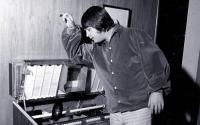Dan PleschFebruary 19, 2003
The US war plan for Iraq is being prepared in great detail by Donald Rumsfeld and President Bush's civilian advisers in the White House. America's generals are outraged at this micromanagement. It is as if Britain's war plan was made by Alastair Campbell and Geoff Hoon.
Colin Powell created the idea that the US should always use massive and overwhelming force in any war when he was chairman of the Joint Chiefs of Staff in the late 1980s. Rumsfeld has set aside the Powell doctrine in favour of a more adventurous approach.
Despite the war talk, the US has not yet sent enough forces from Germany or the US for a mass invasion. Most of the forces that Rumsfeld told the press had been alerted in January are still in their barracks. This is partly because Rumsfeld believes the war can be won with few ground troops and also because of arguments inside the Pentagon about how to fight the war.
Rumsfeld intends to abandon what he sees as old ideas, such as using tanks to seize territory. Instead he favours thousands of precision air strikes and an immediate landing around and inside Baghdad. This attack is intended to be a "head transplant". The transplant would kill Saddam or force him to flee. He would be replaced - for the time being - with a figurehead from the existing regime who would keep the existing army and Ba'ath party in place. This would help keep order and prevent a civil war with the Kurds in the north and the marsh Arabs in the south. Democracy and human rights are not high up the list of priorities.
The troops that the US has sent already could carry out this transplant operation. They include the 3rd Mechanised Division and 1st Marine Division in Kuwait. Between them these have more than 300 tanks, hundreds of smaller armoured vehicles and a great many attack and transport helicopters. The marines train to fly hundreds of miles inland supported by their Harrier jump jets and tanks. Britain will soon have another 100 or so tanks and helicopter-borne troops.
The 101st Air Assault Division and 82nd Airborne have more than 20,000 soldiers trained to attack by helicopter. Finally, the 4th Mechanised Division has been given orders to go. This division forms "task force ironhorse" of some 37,000 soldiers including, more than 100 tanks and bridge-building engineers. The "Ironhorse" Division is also the first computerised,"Digital Division". One advantage it has is that all its vehicles have global positioning systems (GPS), which automatically provide a picture of every vehicle's location. This means the army has to worry less about being subject to friendly fire from the air force as it rushes across the desert.
US troops can capture airfields deep inside Iraq, and within hours use them to fly in hundreds of tanks and troops. They already have prepared several bases in Kurdistan. US forces could also get to Iraq from the British airfields in Cyprus, and old Soviet bases in Bulgaria, Romania and Georgia as more well-known ones in the Gulf and Turkey.
The US army and air force have spent years practising these airlanding operations. Since the Gulf war the Pentagon has doubled the rate at which it can fly in tank units, with the C-17 transport plane designed to use short and roughly prepared airfields.
Airlanding operations could see tanks rolling off the back of transport planes at Saddam Hussein airport and driving straight for central Baghdad. At the same time as this "head transplant" took place, helicopter units operating east from the Jordanian border would have the job of preventing any Scud attack on Israel, while air force bombers attempted to burn away any stocks of chemical or biological weapons.
There are numerous reports that Saddam's troops have been told through leaflets and radio broadcasts that they will not be attacked if they stay put. These messages have been backed up with offers of large amounts of cash to bribe senior commanders. This was a highly effective method of waging war in Afghanistan.
Any Iraqi troops that do move will be spotted and destroyed by US air power. In the Gulf war, the B-52s carried old-style "dumb bombs". Today each of the 70 B-52s carries 50 bombs directed by GPS to their target. Theoretically, these planes alone could attack 3,500 aim points in Iraq in one go. And the US has 500 other planes based nearby.
Saddam may not topple quickly like one of the communist regimes of eastern Europe. US troops have been often ambushed in Afghanistan and may find themselves in trouble in the cities of Iraq. Helicopters look glamourous but like the cavalry horses they replaced they are vulnerable to gun fire.
This attack plan, designed to shock and awe the enemy into surrender, may win the war in days. Alternatively, the shock and awe may merely be designed to intimidate both Saddam and the UN security council. If in fact the White House is still very cautious about risking US lives, then it could well be content in the end to go along with a UN-backed process. Remember that, even after September 11, the White House held back from putting US troops in harm's way in the search for Osama bin Laden in Afghanistan. Even now, president Bush may want to lead a UN-backed force to minimise the risk of US casualties and global disorder to re-emphasise the "compassionate conservative" strategy that won him his first term.
· Dan Plesch is a senior research fellow at the Royal United Services Institute [email protected]






